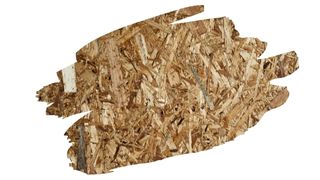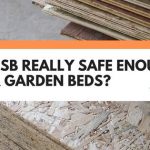OSB is probably one of the strongest manufactured woods out there.
In terms of its shear strength along, OSB sits heads and shoulders above Plywood. Which is why this material often gets used for roof sheathing.
And, unlike MDF, those compressed OSB boards are surprisingly water-resistant, in that it doesn’t readily absorb moisture.
Still, water-resistant does not mean waterproof. And if OSB becomes drenched, it can take weeks (even months) for it to eventually dry out.
So, in this post, we reveal whether or not OSB is more (or less) likely to rot than Plywood. You will also find out which OSB grades (there are four) are suited for exterior use.
And keep reading to discover which type of industrial-strength weatherproof tape you should use to seal OSB seams.

This post may contain affiliate links to products that we receive a commission for (at no additional cost to you). Learn more here.
Is OSB More Likely To Rot Than Plywood?
In theory, no it isn’t.
You see, rot is caused by moisture. If moisture becomes absorbed by these materials, then the combination of moisture and wood strands, means bacteria can grow.
So, the key to preventing rot lies in making these materials water-resistant.
Now, all things being equal, OSB (aka Oriented Strand Board) is more water-resistant than Plywood. That is because OSB is a much denser material.
And OSB’s density means that moisture can take a long time to become slowly absorbed by it.
So, OSB panels are less likely to soak up a lot of moisture (compared to Plywood). And in turn, less likely to rot.
At least all of the above is the working theory.
In practice, neither Plywood or OSB are all that water-resistant. Both materials will need to be sealed to protect them from rot and decay.
Plus, while moisture takes longer to become absorbed, it takes even longer for well-soaked OSB to dry out afterwards.
And any extended drying time, will increase the likelihood of OSB rotting (compared to Plywood).
Related Post: Is OSB Really Safe Enough For Indoor Use?
Do You Really Need To Seal OSB Board? And Can OSB Even Be Made Waterproof?
First off, OSB needs sealing. OSB is not waterproof.
At most, depending on the grade of OSB, it is at best water-resistant.
The highest graded OSB boards are OSB/3 and OSB/4. These boards are the most water-resistant type of OSB you can get (as well as the most expensive).
They can handle high-humidity environments, all thanks to the water-repelling adhesives used to manufacture them. This is why they are used for roofs and siding.
But, grades OSB/1 and OSB/2 are the more typically available grades that everyday folk tend to buy. These low-graded OSB boards are strong (with incredible shear strength).
However, they are not water-resistant. And they’ll become damaged if left unsealed in areas that experience a lot of splash-back (kitchens, bathrooms, etc).
Related Post: Can OSB Board Really Get Wet? (7 Things You Need To Know)
So What Do You Seal OSB With To Make It Waterproof?
You will need to use a clear coating primer sealer on this material.
And the best one you can use is actually a sealer designed for MDF. However, it works surprisingly well on OSB too.
Rustin’s Quick Drying Clear MDF Primer Sealer only needs one coat to protect interior OSB from moisture.
It dries in less than 2 hours. Plus, a coat of paint will adhere onto this sealer too. So, it is the perfect primer to use if you plan on painting over OSB.
You can learn more about this primer sealer over on Toolstation.com
Now, a primer sealer will work great on the surface of OSB. But, those OSB seams will need additional attention.
How Many Coats Of Primer Should You Use On OSB? Follow the instructions on the product. But, as a good rule of thumb, at least three coats should get the job done.
But Do OSB Seams Always Need To Be Taped Up?
Ideally, they should, since those gaps are notorious for allowing moisture and air in. Which is why you should use tape to prevent air from seeping between those seams.
The best type of tape you can use is 3M All Weather Flashing Tape.
This industrial-strength waterproof tape has been used to seal air gaps in windows and doors. And it will do the same for those OSB seams.
It can also handle moisture with ease. And it can even adhere onto a damp surface.
And Can You Put Polyurethane On OSB? Will It Leave A Nice Finish?
It certainly can, but only provided you use an oil-based polyurethane.
If you use a water-based polyurethane, you may end up with raised grain problems — which are a pain to smooth out.
And always make sure you sand between coats, applying at least three coats for proper coverage.
Also, use a synthetic bristle brush to apply polyurethane, if you want a bubble-free finish.
Related Post: Can You Avoid Dried Air Bubbles Appearing In Your Polyurethane Finish?
To Wrap Up, Here Are The 3 Key Takeaways From This Post…
- 1). OSB is so dense it absorbs water more slowly than Plywood, making it less susceptible to rot.
- 2). But, OSB takes ages to dry out (if it has become drenched with moisture/water). And during this time, it is more likely to succumb to rot and decay.
- 3). You can seal OSB with primer sealer to make it more waterproof. However, only OSB grades OSB/3 and OSB/4, should be used on exterior structures.
References:
Simple and accurate temperature correction for moisture pin calibrations in oriented strand board (fs.fed.us)



